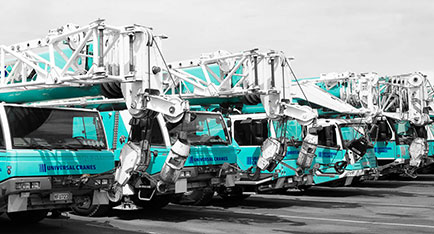On 5 October 2011, due to navigation errors near the Astrolabe Reef, the cargo ship Rena ran aground near Tauranga, New Zealand. The Rena, a 236-metre container ship, was carrying 1,368 containers and 1,733 tonnes of heavy fuel oil when she hit the reef. Auckland Cranes was engaged by Svitzer Salver to recover containers from the precariously poised ship.
Auckland Cranes deployed a Kobelco 7150 and a Liebherr LR1280 crane (supplied by Smith Crane & Construction). A P&B Sea-Tow barge was deployed from Australia to carry the two cranes. The Port of Tauranga provided the assembly area for the crawler cranes and a berth to walk the cranes onto Sea-Tow 60. Once the cranes were secured to the barge, it was towed to the site and moored at the stern of the Rena where the containers were lifted off the ship and onto the tug Go Canopus.
In addition to removing freight from the Rena and ocean,, the barge-mounted cranes also supported demolition works including cutting up the wreck and removing parts.
The location of the Rena on the Astrolabe reef made this a very challenging project. The wreck was on a 22-degree list when the salvage operation commenced, making standing and walking difficult. Getting access to the containers from a man cage was impossible because of the pitching and rolling of the barge caused by the ocean swell.
Due to the list of the ship and the lean of the containers, the crew had to identify the sequence in which the containers could be safely removed. Prior to lifting each container, additional lashings were applied to the neighbouring containers to prevent them from falling. This painstaking process had to be repeated for each container.
Rough seas made it impossible to place a container in an exact location on the shuttle barge without two or three crew members controlling the container tag lines. A highly competent dogman was required to predict the movements of the load and the barge and to time the lowering of the hook to suit.
Health and safety risks for the project team included wind, sunburn, dehydration, fatigue and physical strain. As well as managing the risks to personnel, Auckland Waikato Cranes implemented numerous safety measures for the cranes themselves prior to deploying the machines to sea. Foul weather boom rests were installed for when the cranes were out of service as well as stools to prop the counterweights on. These measures reduced the wear and tear caused by the constant swaying motion of the barge.
Tugger hoists were fitted to stop the pendulum effect of the hook (swinging the load out of radius or away from the crane) caused by the ocean swell as it passed under the barge.





